PSYC0038 - RMP1 Take Home Test: Research Methods, Ethics & Statistics
VerifiedAdded on 2023/06/15
|14
|2510
|119
Homework Assignment
AI Summary
This document presents the solutions to a take-home test for the PSYC0038 Research Methods in Psychology I (RMP1) course. The test covers a range of topics including ethical considerations in research, research design, statistical analysis, and interpretation of research findings. Questions address ethical principles, elements of research papers, identification of research designs, measurement levels, appropriate statistical tests, and hypothesis formulation. The test also includes calculations of correlation coefficients, chi-squared tests, and probability based on normal distribution. The solutions provide answers to multiple-choice questions, fill-in-the-blank questions, and interpretations of statistical results, offering a comprehensive review of key concepts in research methods and statistics relevant to psychology.
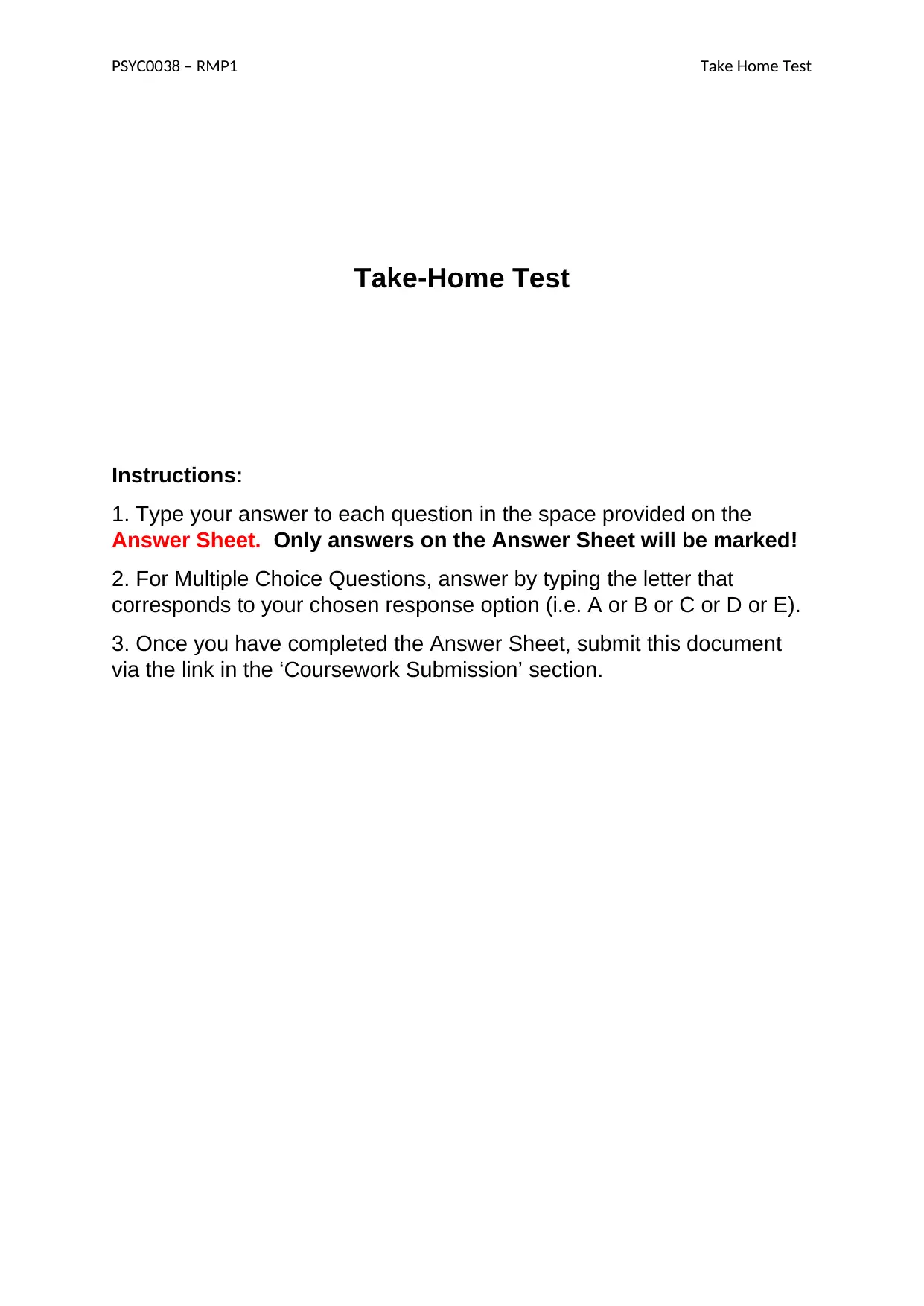
PSYC0038 – RMP1 Take Home Test
Take-Home Test
Instructions:
1. Type your answer to each question in the space provided on the
Answer Sheet. Only answers on the Answer Sheet will be marked!
2. For Multiple Choice Questions, answer by typing the letter that
corresponds to your chosen response option (i.e. A or B or C or D or E).
3. Once you have completed the Answer Sheet, submit this document
via the link in the ‘Coursework Submission’ section.
Take-Home Test
Instructions:
1. Type your answer to each question in the space provided on the
Answer Sheet. Only answers on the Answer Sheet will be marked!
2. For Multiple Choice Questions, answer by typing the letter that
corresponds to your chosen response option (i.e. A or B or C or D or E).
3. Once you have completed the Answer Sheet, submit this document
via the link in the ‘Coursework Submission’ section.
Paraphrase This Document
Need a fresh take? Get an instant paraphrase of this document with our AI Paraphraser
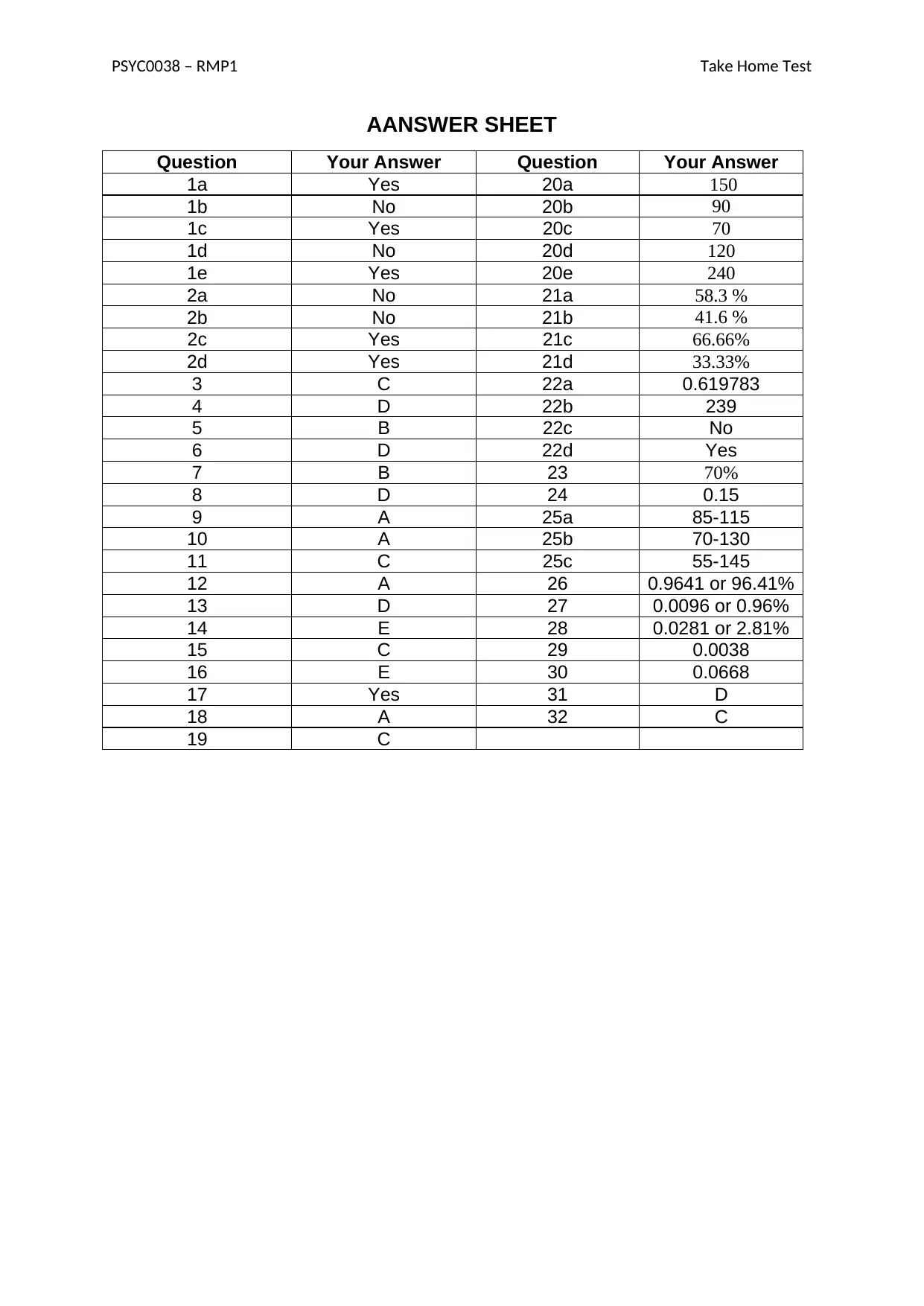
PSYC0038 – RMP1 Take Home Test
AANSWER SHEET
Question Your Answer Question Your Answer
1a Yes 20a 150
1b No 20b 90
1c Yes 20c 70
1d No 20d 120
1e Yes 20e 240
2a No 21a 58.3 %
2b No 21b 41.6 %
2c Yes 21c 66.66%
2d Yes 21d 33.33%
3 C 22a 0.619783
4 D 22b 239
5 B 22c No
6 D 22d Yes
7 B 23 70%
8 D 24 0.15
9 A 25a 85-115
10 A 25b 70-130
11 C 25c 55-145
12 A 26 0.9641 or 96.41%
13 D 27 0.0096 or 0.96%
14 E 28 0.0281 or 2.81%
15 C 29 0.0038
16 E 30 0.0668
17 Yes 31 D
18 A 32 C
19 C
AANSWER SHEET
Question Your Answer Question Your Answer
1a Yes 20a 150
1b No 20b 90
1c Yes 20c 70
1d No 20d 120
1e Yes 20e 240
2a No 21a 58.3 %
2b No 21b 41.6 %
2c Yes 21c 66.66%
2d Yes 21d 33.33%
3 C 22a 0.619783
4 D 22b 239
5 B 22c No
6 D 22d Yes
7 B 23 70%
8 D 24 0.15
9 A 25a 85-115
10 A 25b 70-130
11 C 25c 55-145
12 A 26 0.9641 or 96.41%
13 D 27 0.0096 or 0.96%
14 E 28 0.0281 or 2.81%
15 C 29 0.0038
16 E 30 0.0668
17 Yes 31 D
18 A 32 C
19 C
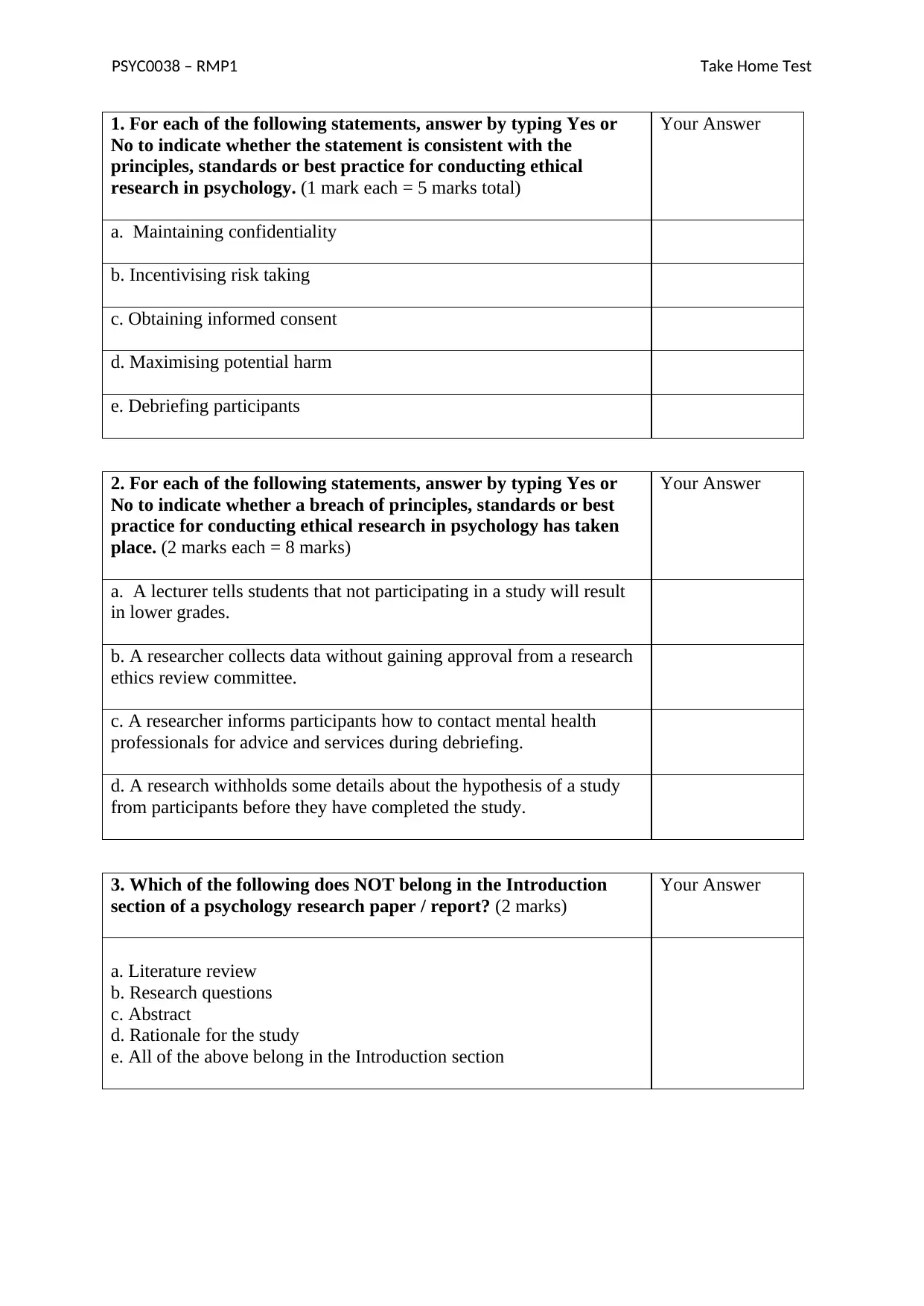
PSYC0038 – RMP1 Take Home Test
1. For each of the following statements, answer by typing Yes or
No to indicate whether the statement is consistent with the
principles, standards or best practice for conducting ethical
research in psychology. (1 mark each = 5 marks total)
Your Answer
a. Maintaining confidentiality
b. Incentivising risk taking
c. Obtaining informed consent
d. Maximising potential harm
e. Debriefing participants
2. For each of the following statements, answer by typing Yes or
No to indicate whether a breach of principles, standards or best
practice for conducting ethical research in psychology has taken
place. (2 marks each = 8 marks)
Your Answer
a. A lecturer tells students that not participating in a study will result
in lower grades.
b. A researcher collects data without gaining approval from a research
ethics review committee.
c. A researcher informs participants how to contact mental health
professionals for advice and services during debriefing.
d. A research withholds some details about the hypothesis of a study
from participants before they have completed the study.
3. Which of the following does NOT belong in the Introduction
section of a psychology research paper / report? (2 marks)
Your Answer
a. Literature review
b. Research questions
c. Abstract
d. Rationale for the study
e. All of the above belong in the Introduction section
1. For each of the following statements, answer by typing Yes or
No to indicate whether the statement is consistent with the
principles, standards or best practice for conducting ethical
research in psychology. (1 mark each = 5 marks total)
Your Answer
a. Maintaining confidentiality
b. Incentivising risk taking
c. Obtaining informed consent
d. Maximising potential harm
e. Debriefing participants
2. For each of the following statements, answer by typing Yes or
No to indicate whether a breach of principles, standards or best
practice for conducting ethical research in psychology has taken
place. (2 marks each = 8 marks)
Your Answer
a. A lecturer tells students that not participating in a study will result
in lower grades.
b. A researcher collects data without gaining approval from a research
ethics review committee.
c. A researcher informs participants how to contact mental health
professionals for advice and services during debriefing.
d. A research withholds some details about the hypothesis of a study
from participants before they have completed the study.
3. Which of the following does NOT belong in the Introduction
section of a psychology research paper / report? (2 marks)
Your Answer
a. Literature review
b. Research questions
c. Abstract
d. Rationale for the study
e. All of the above belong in the Introduction section
⊘ This is a preview!⊘
Do you want full access?
Subscribe today to unlock all pages.

Trusted by 1+ million students worldwide
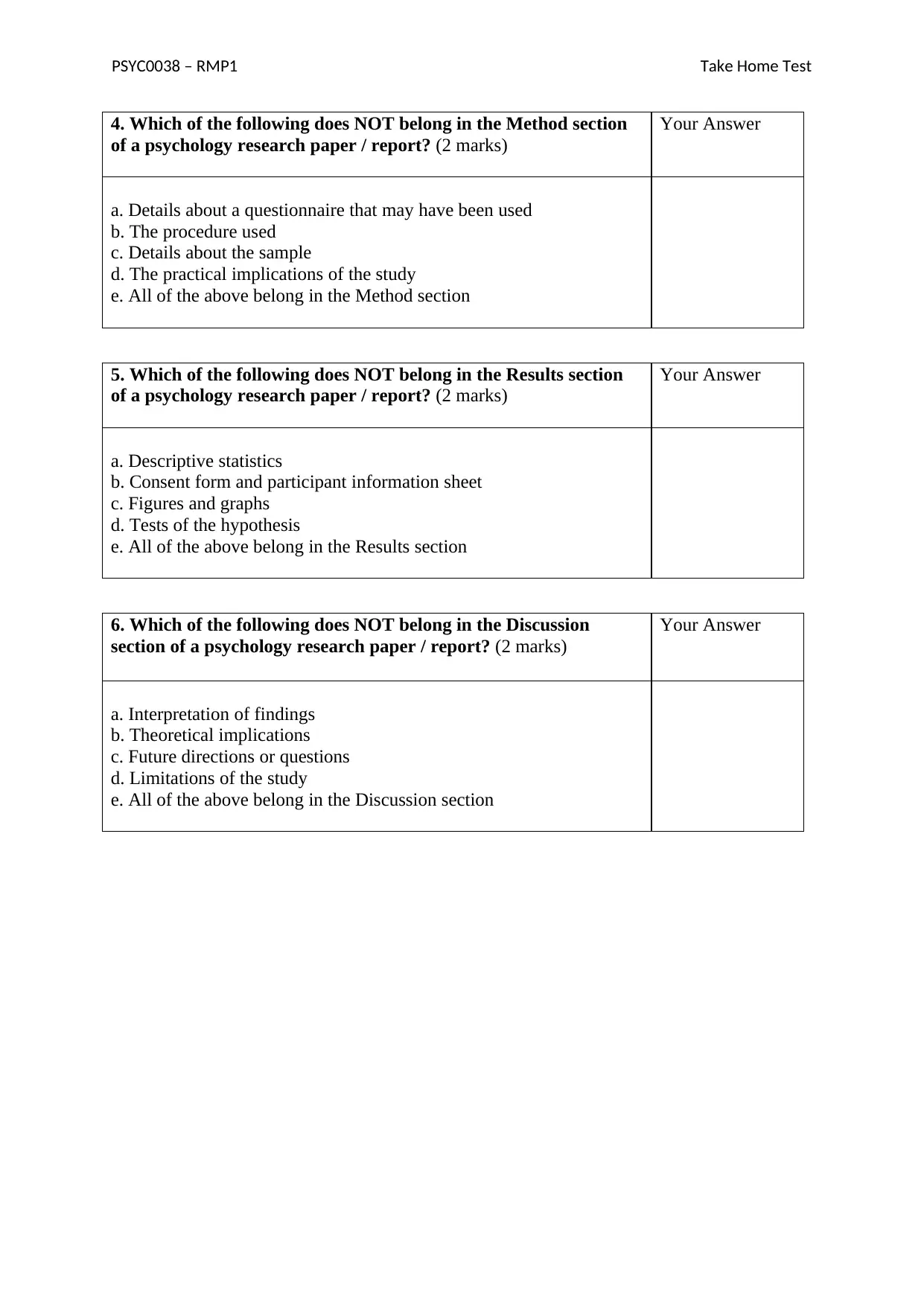
PSYC0038 – RMP1 Take Home Test
4. Which of the following does NOT belong in the Method section
of a psychology research paper / report? (2 marks)
Your Answer
a. Details about a questionnaire that may have been used
b. The procedure used
c. Details about the sample
d. The practical implications of the study
e. All of the above belong in the Method section
5. Which of the following does NOT belong in the Results section
of a psychology research paper / report? (2 marks)
Your Answer
a. Descriptive statistics
b. Consent form and participant information sheet
c. Figures and graphs
d. Tests of the hypothesis
e. All of the above belong in the Results section
6. Which of the following does NOT belong in the Discussion
section of a psychology research paper / report? (2 marks)
Your Answer
a. Interpretation of findings
b. Theoretical implications
c. Future directions or questions
d. Limitations of the study
e. All of the above belong in the Discussion section
4. Which of the following does NOT belong in the Method section
of a psychology research paper / report? (2 marks)
Your Answer
a. Details about a questionnaire that may have been used
b. The procedure used
c. Details about the sample
d. The practical implications of the study
e. All of the above belong in the Method section
5. Which of the following does NOT belong in the Results section
of a psychology research paper / report? (2 marks)
Your Answer
a. Descriptive statistics
b. Consent form and participant information sheet
c. Figures and graphs
d. Tests of the hypothesis
e. All of the above belong in the Results section
6. Which of the following does NOT belong in the Discussion
section of a psychology research paper / report? (2 marks)
Your Answer
a. Interpretation of findings
b. Theoretical implications
c. Future directions or questions
d. Limitations of the study
e. All of the above belong in the Discussion section
Paraphrase This Document
Need a fresh take? Get an instant paraphrase of this document with our AI Paraphraser
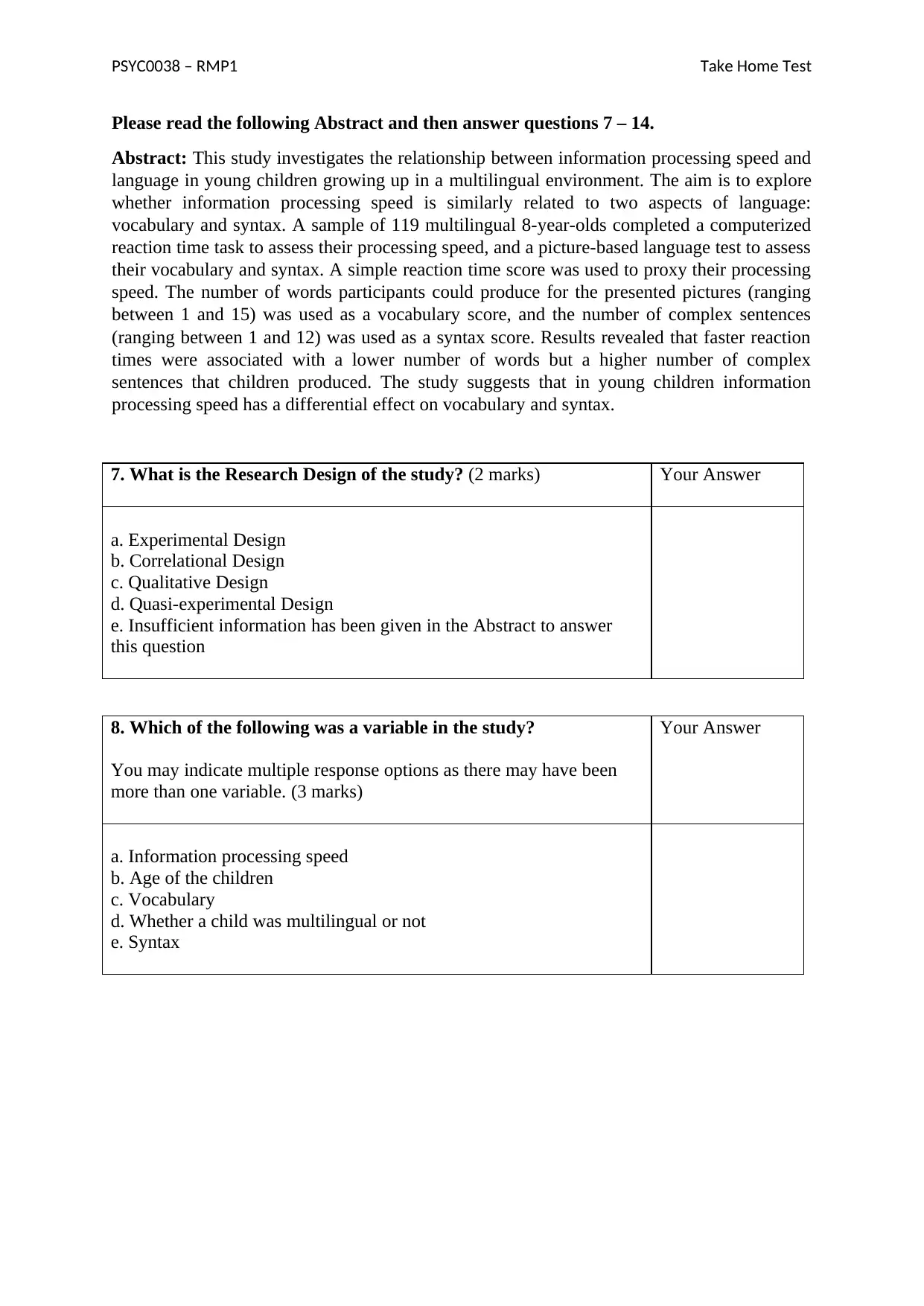
PSYC0038 – RMP1 Take Home Test
Please read the following Abstract and then answer questions 7 – 14.
Abstract: This study investigates the relationship between information processing speed and
language in young children growing up in a multilingual environment. The aim is to explore
whether information processing speed is similarly related to two aspects of language:
vocabulary and syntax. A sample of 119 multilingual 8-year-olds completed a computerized
reaction time task to assess their processing speed, and a picture-based language test to assess
their vocabulary and syntax. A simple reaction time score was used to proxy their processing
speed. The number of words participants could produce for the presented pictures (ranging
between 1 and 15) was used as a vocabulary score, and the number of complex sentences
(ranging between 1 and 12) was used as a syntax score. Results revealed that faster reaction
times were associated with a lower number of words but a higher number of complex
sentences that children produced. The study suggests that in young children information
processing speed has a differential effect on vocabulary and syntax.
7. What is the Research Design of the study? (2 marks) Your Answer
a. Experimental Design
b. Correlational Design
c. Qualitative Design
d. Quasi-experimental Design
e. Insufficient information has been given in the Abstract to answer
this question
8. Which of the following was a variable in the study?
You may indicate multiple response options as there may have been
more than one variable. (3 marks)
Your Answer
a. Information processing speed
b. Age of the children
c. Vocabulary
d. Whether a child was multilingual or not
e. Syntax
Please read the following Abstract and then answer questions 7 – 14.
Abstract: This study investigates the relationship between information processing speed and
language in young children growing up in a multilingual environment. The aim is to explore
whether information processing speed is similarly related to two aspects of language:
vocabulary and syntax. A sample of 119 multilingual 8-year-olds completed a computerized
reaction time task to assess their processing speed, and a picture-based language test to assess
their vocabulary and syntax. A simple reaction time score was used to proxy their processing
speed. The number of words participants could produce for the presented pictures (ranging
between 1 and 15) was used as a vocabulary score, and the number of complex sentences
(ranging between 1 and 12) was used as a syntax score. Results revealed that faster reaction
times were associated with a lower number of words but a higher number of complex
sentences that children produced. The study suggests that in young children information
processing speed has a differential effect on vocabulary and syntax.
7. What is the Research Design of the study? (2 marks) Your Answer
a. Experimental Design
b. Correlational Design
c. Qualitative Design
d. Quasi-experimental Design
e. Insufficient information has been given in the Abstract to answer
this question
8. Which of the following was a variable in the study?
You may indicate multiple response options as there may have been
more than one variable. (3 marks)
Your Answer
a. Information processing speed
b. Age of the children
c. Vocabulary
d. Whether a child was multilingual or not
e. Syntax
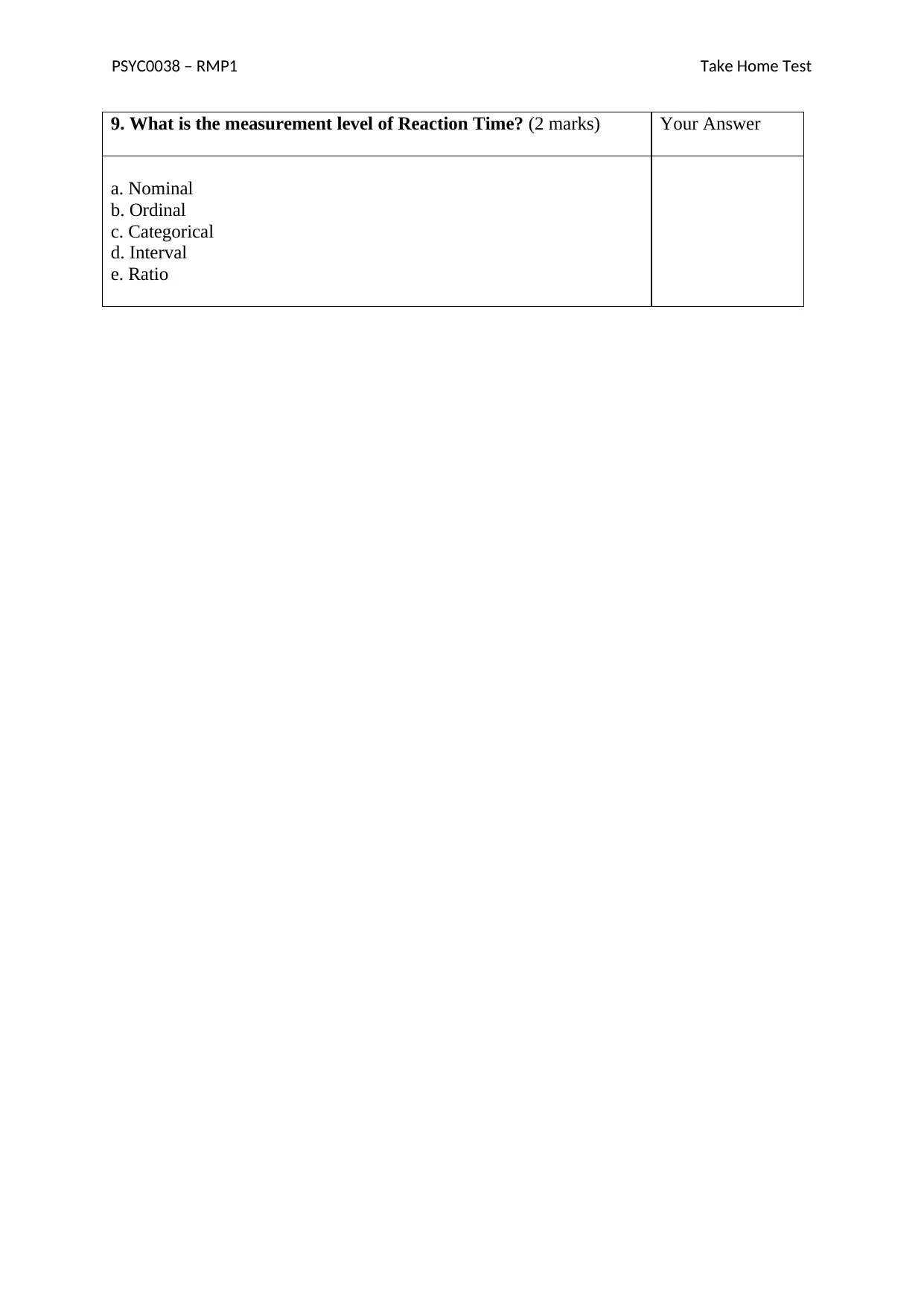
PSYC0038 – RMP1 Take Home Test
9. What is the measurement level of Reaction Time? (2 marks) Your Answer
a. Nominal
b. Ordinal
c. Categorical
d. Interval
e. Ratio
9. What is the measurement level of Reaction Time? (2 marks) Your Answer
a. Nominal
b. Ordinal
c. Categorical
d. Interval
e. Ratio
⊘ This is a preview!⊘
Do you want full access?
Subscribe today to unlock all pages.

Trusted by 1+ million students worldwide
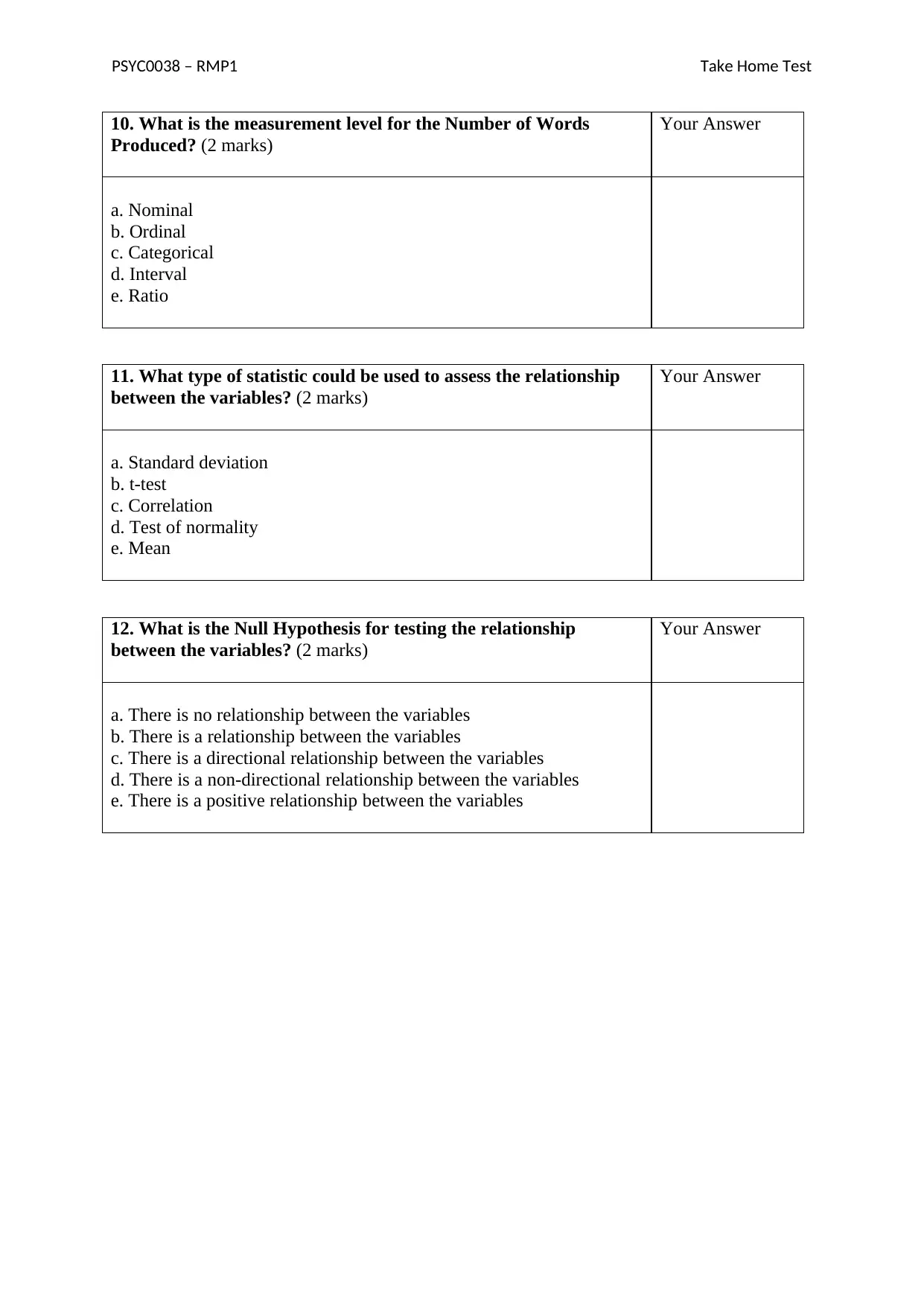
PSYC0038 – RMP1 Take Home Test
10. What is the measurement level for the Number of Words
Produced? (2 marks)
Your Answer
a. Nominal
b. Ordinal
c. Categorical
d. Interval
e. Ratio
11. What type of statistic could be used to assess the relationship
between the variables? (2 marks)
Your Answer
a. Standard deviation
b. t-test
c. Correlation
d. Test of normality
e. Mean
12. What is the Null Hypothesis for testing the relationship
between the variables? (2 marks)
Your Answer
a. There is no relationship between the variables
b. There is a relationship between the variables
c. There is a directional relationship between the variables
d. There is a non-directional relationship between the variables
e. There is a positive relationship between the variables
10. What is the measurement level for the Number of Words
Produced? (2 marks)
Your Answer
a. Nominal
b. Ordinal
c. Categorical
d. Interval
e. Ratio
11. What type of statistic could be used to assess the relationship
between the variables? (2 marks)
Your Answer
a. Standard deviation
b. t-test
c. Correlation
d. Test of normality
e. Mean
12. What is the Null Hypothesis for testing the relationship
between the variables? (2 marks)
Your Answer
a. There is no relationship between the variables
b. There is a relationship between the variables
c. There is a directional relationship between the variables
d. There is a non-directional relationship between the variables
e. There is a positive relationship between the variables
Paraphrase This Document
Need a fresh take? Get an instant paraphrase of this document with our AI Paraphraser
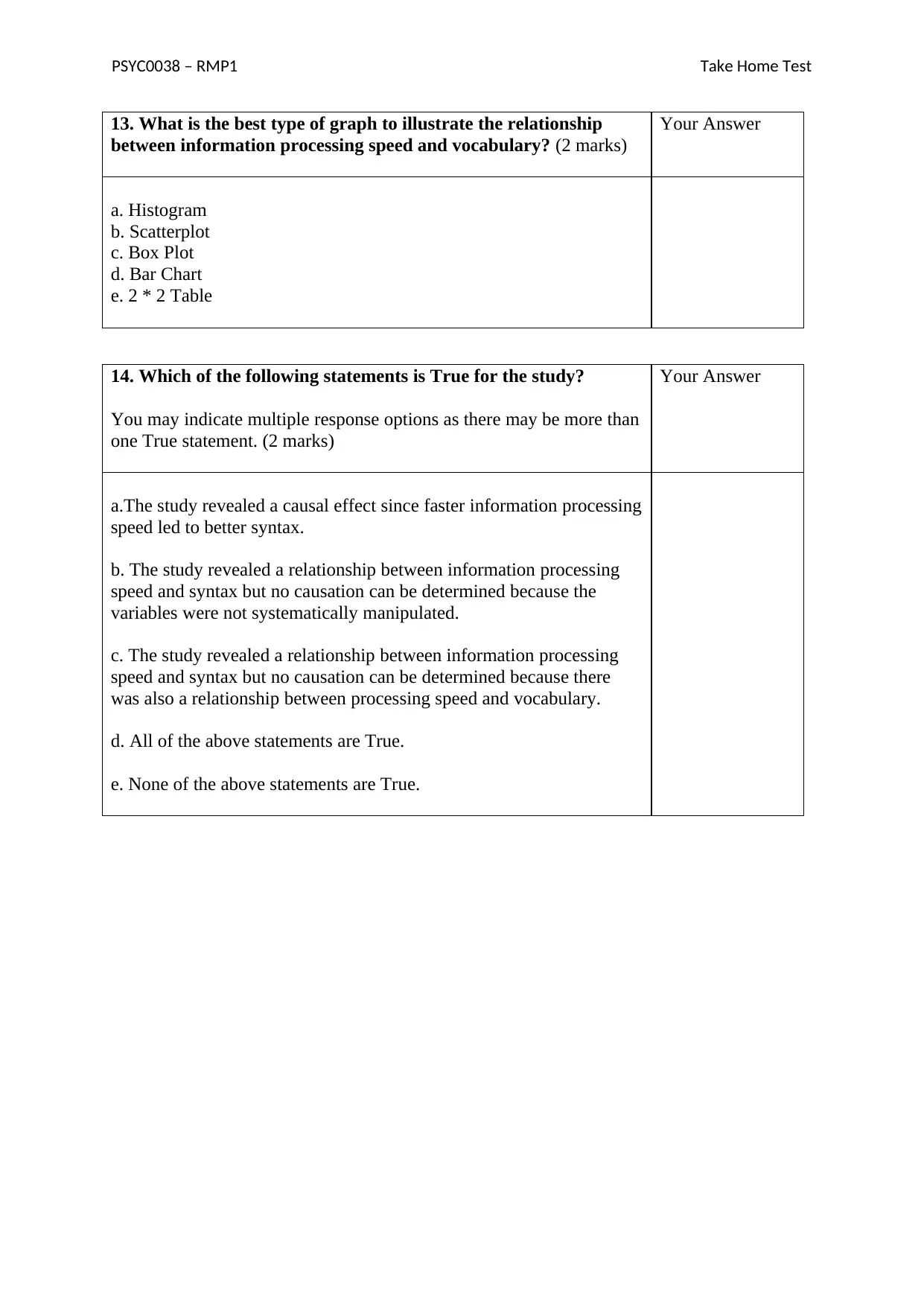
PSYC0038 – RMP1 Take Home Test
13. What is the best type of graph to illustrate the relationship
between information processing speed and vocabulary? (2 marks)
Your Answer
a. Histogram
b. Scatterplot
c. Box Plot
d. Bar Chart
e. 2 * 2 Table
14. Which of the following statements is True for the study?
You may indicate multiple response options as there may be more than
one True statement. (2 marks)
Your Answer
a.The study revealed a causal effect since faster information processing
speed led to better syntax.
b. The study revealed a relationship between information processing
speed and syntax but no causation can be determined because the
variables were not systematically manipulated.
c. The study revealed a relationship between information processing
speed and syntax but no causation can be determined because there
was also a relationship between processing speed and vocabulary.
d. All of the above statements are True.
e. None of the above statements are True.
13. What is the best type of graph to illustrate the relationship
between information processing speed and vocabulary? (2 marks)
Your Answer
a. Histogram
b. Scatterplot
c. Box Plot
d. Bar Chart
e. 2 * 2 Table
14. Which of the following statements is True for the study?
You may indicate multiple response options as there may be more than
one True statement. (2 marks)
Your Answer
a.The study revealed a causal effect since faster information processing
speed led to better syntax.
b. The study revealed a relationship between information processing
speed and syntax but no causation can be determined because the
variables were not systematically manipulated.
c. The study revealed a relationship between information processing
speed and syntax but no causation can be determined because there
was also a relationship between processing speed and vocabulary.
d. All of the above statements are True.
e. None of the above statements are True.
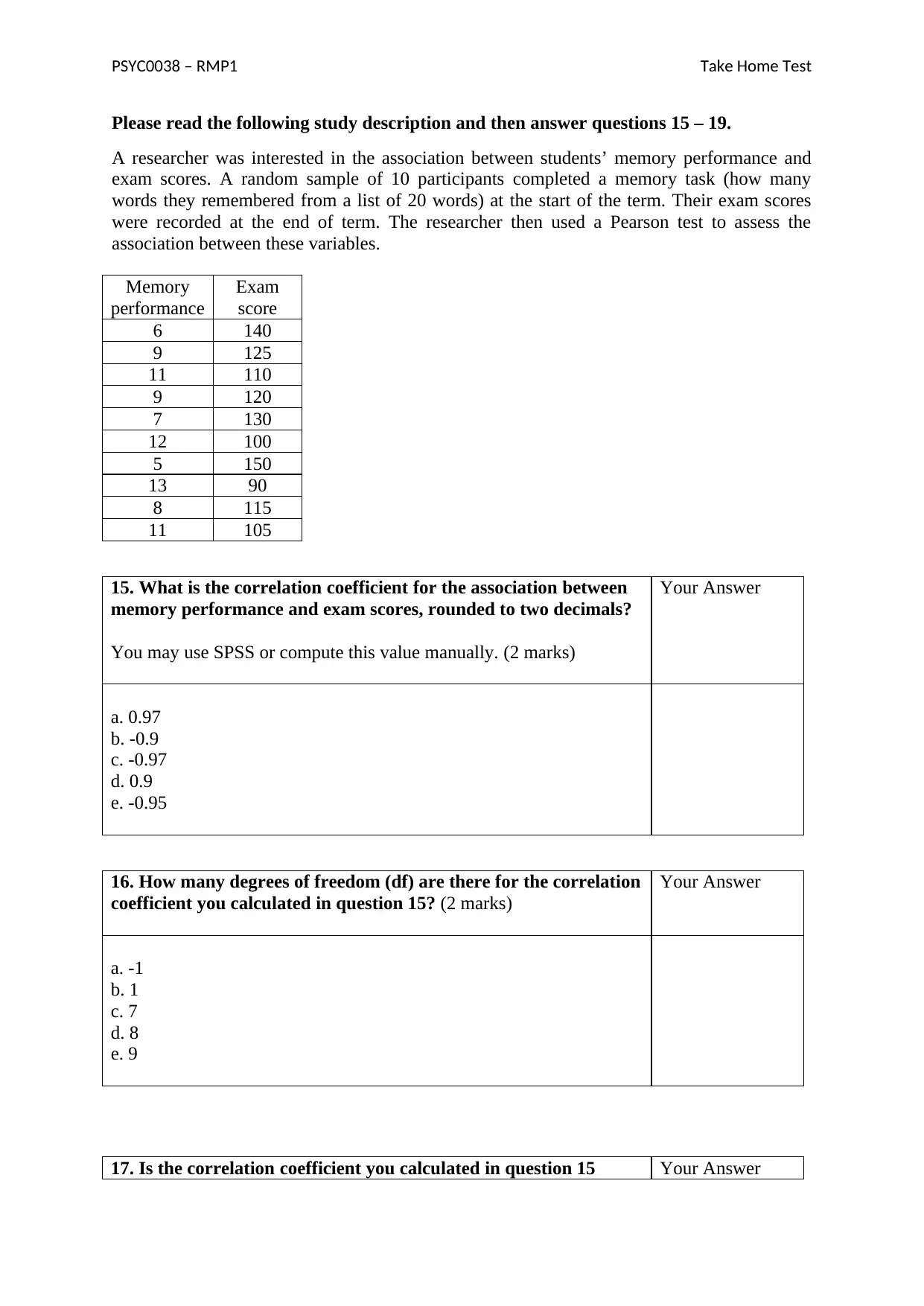
PSYC0038 – RMP1 Take Home Test
Please read the following study description and then answer questions 15 – 19.
A researcher was interested in the association between students’ memory performance and
exam scores. A random sample of 10 participants completed a memory task (how many
words they remembered from a list of 20 words) at the start of the term. Their exam scores
were recorded at the end of term. The researcher then used a Pearson test to assess the
association between these variables.
Memory
performance
Exam
score
6 140
9 125
11 110
9 120
7 130
12 100
5 150
13 90
8 115
11 105
15. What is the correlation coefficient for the association between
memory performance and exam scores, rounded to two decimals?
You may use SPSS or compute this value manually. (2 marks)
Your Answer
a. 0.97
b. -0.9
c. -0.97
d. 0.9
e. -0.95
16. How many degrees of freedom (df) are there for the correlation
coefficient you calculated in question 15? (2 marks)
Your Answer
a. -1
b. 1
c. 7
d. 8
e. 9
17. Is the correlation coefficient you calculated in question 15 Your Answer
Please read the following study description and then answer questions 15 – 19.
A researcher was interested in the association between students’ memory performance and
exam scores. A random sample of 10 participants completed a memory task (how many
words they remembered from a list of 20 words) at the start of the term. Their exam scores
were recorded at the end of term. The researcher then used a Pearson test to assess the
association between these variables.
Memory
performance
Exam
score
6 140
9 125
11 110
9 120
7 130
12 100
5 150
13 90
8 115
11 105
15. What is the correlation coefficient for the association between
memory performance and exam scores, rounded to two decimals?
You may use SPSS or compute this value manually. (2 marks)
Your Answer
a. 0.97
b. -0.9
c. -0.97
d. 0.9
e. -0.95
16. How many degrees of freedom (df) are there for the correlation
coefficient you calculated in question 15? (2 marks)
Your Answer
a. -1
b. 1
c. 7
d. 8
e. 9
17. Is the correlation coefficient you calculated in question 15 Your Answer
⊘ This is a preview!⊘
Do you want full access?
Subscribe today to unlock all pages.

Trusted by 1+ million students worldwide
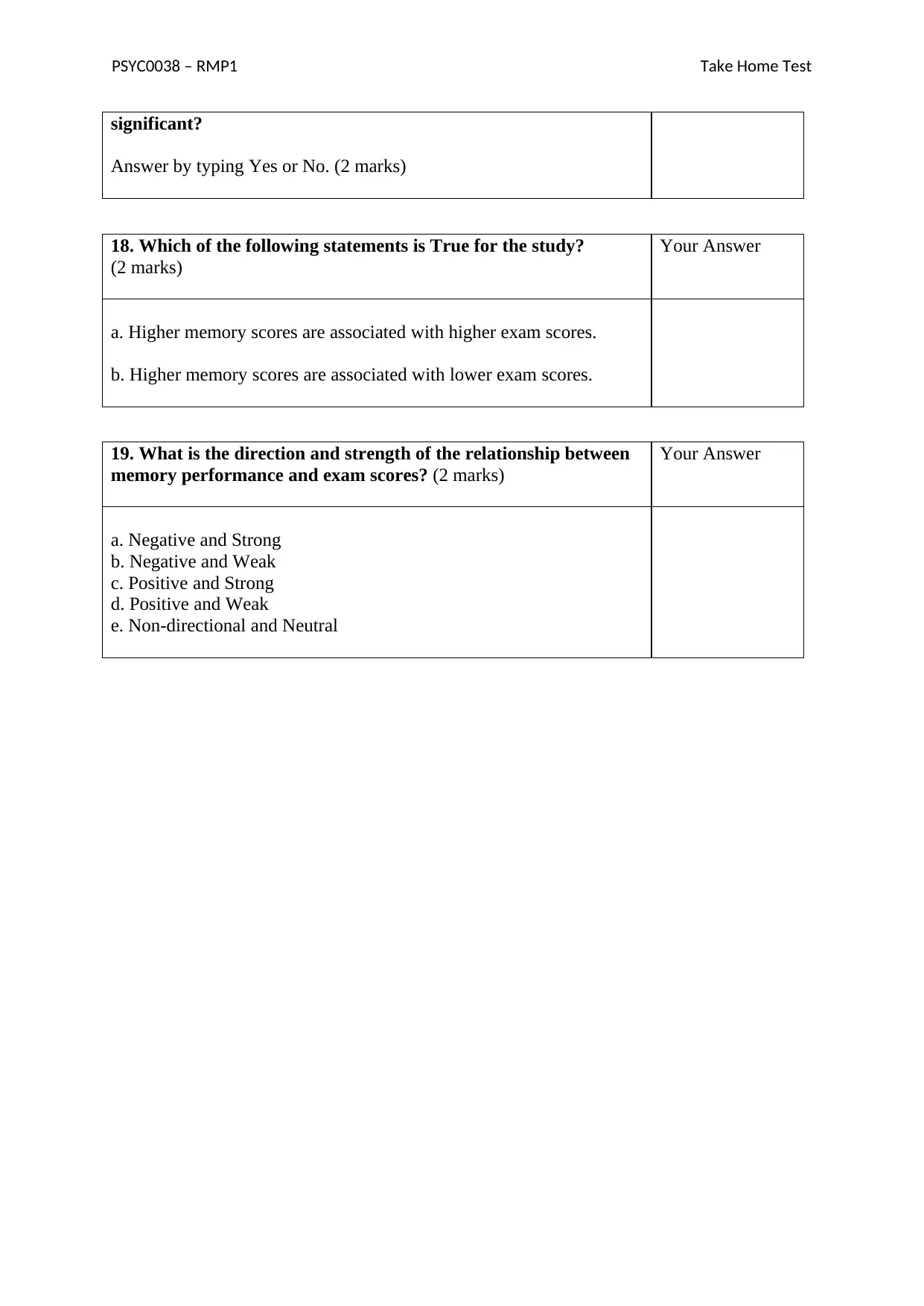
PSYC0038 – RMP1 Take Home Test
significant?
Answer by typing Yes or No. (2 marks)
18. Which of the following statements is True for the study?
(2 marks)
Your Answer
a. Higher memory scores are associated with higher exam scores.
b. Higher memory scores are associated with lower exam scores.
19. What is the direction and strength of the relationship between
memory performance and exam scores? (2 marks)
Your Answer
a. Negative and Strong
b. Negative and Weak
c. Positive and Strong
d. Positive and Weak
e. Non-directional and Neutral
significant?
Answer by typing Yes or No. (2 marks)
18. Which of the following statements is True for the study?
(2 marks)
Your Answer
a. Higher memory scores are associated with higher exam scores.
b. Higher memory scores are associated with lower exam scores.
19. What is the direction and strength of the relationship between
memory performance and exam scores? (2 marks)
Your Answer
a. Negative and Strong
b. Negative and Weak
c. Positive and Strong
d. Positive and Weak
e. Non-directional and Neutral
Paraphrase This Document
Need a fresh take? Get an instant paraphrase of this document with our AI Paraphraser
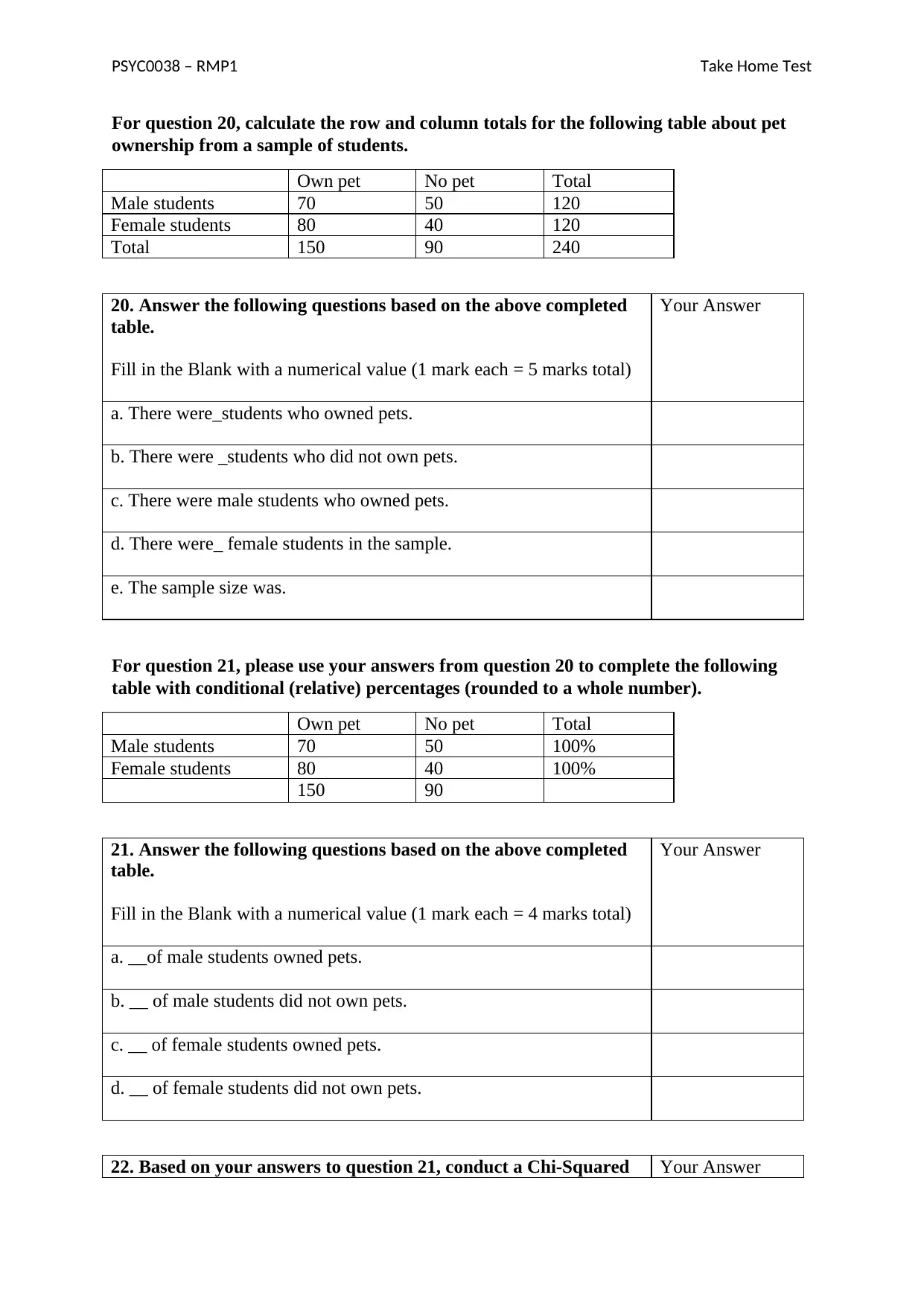
PSYC0038 – RMP1 Take Home Test
For question 20, calculate the row and column totals for the following table about pet
ownership from a sample of students.
Own pet No pet Total
Male students 70 50 120
Female students 80 40 120
Total 150 90 240
20. Answer the following questions based on the above completed
table.
Fill in the Blank with a numerical value (1 mark each = 5 marks total)
Your Answer
a. There were_students who owned pets.
b. There were _students who did not own pets.
c. There were male students who owned pets.
d. There were_ female students in the sample.
e. The sample size was.
For question 21, please use your answers from question 20 to complete the following
table with conditional (relative) percentages (rounded to a whole number).
Own pet No pet Total
Male students 70 50 100%
Female students 80 40 100%
150 90
21. Answer the following questions based on the above completed
table.
Fill in the Blank with a numerical value (1 mark each = 4 marks total)
Your Answer
a. __of male students owned pets.
b. __ of male students did not own pets.
c. __ of female students owned pets.
d. __ of female students did not own pets.
22. Based on your answers to question 21, conduct a Chi-Squared Your Answer
For question 20, calculate the row and column totals for the following table about pet
ownership from a sample of students.
Own pet No pet Total
Male students 70 50 120
Female students 80 40 120
Total 150 90 240
20. Answer the following questions based on the above completed
table.
Fill in the Blank with a numerical value (1 mark each = 5 marks total)
Your Answer
a. There were_students who owned pets.
b. There were _students who did not own pets.
c. There were male students who owned pets.
d. There were_ female students in the sample.
e. The sample size was.
For question 21, please use your answers from question 20 to complete the following
table with conditional (relative) percentages (rounded to a whole number).
Own pet No pet Total
Male students 70 50 100%
Female students 80 40 100%
150 90
21. Answer the following questions based on the above completed
table.
Fill in the Blank with a numerical value (1 mark each = 4 marks total)
Your Answer
a. __of male students owned pets.
b. __ of male students did not own pets.
c. __ of female students owned pets.
d. __ of female students did not own pets.
22. Based on your answers to question 21, conduct a Chi-Squared Your Answer
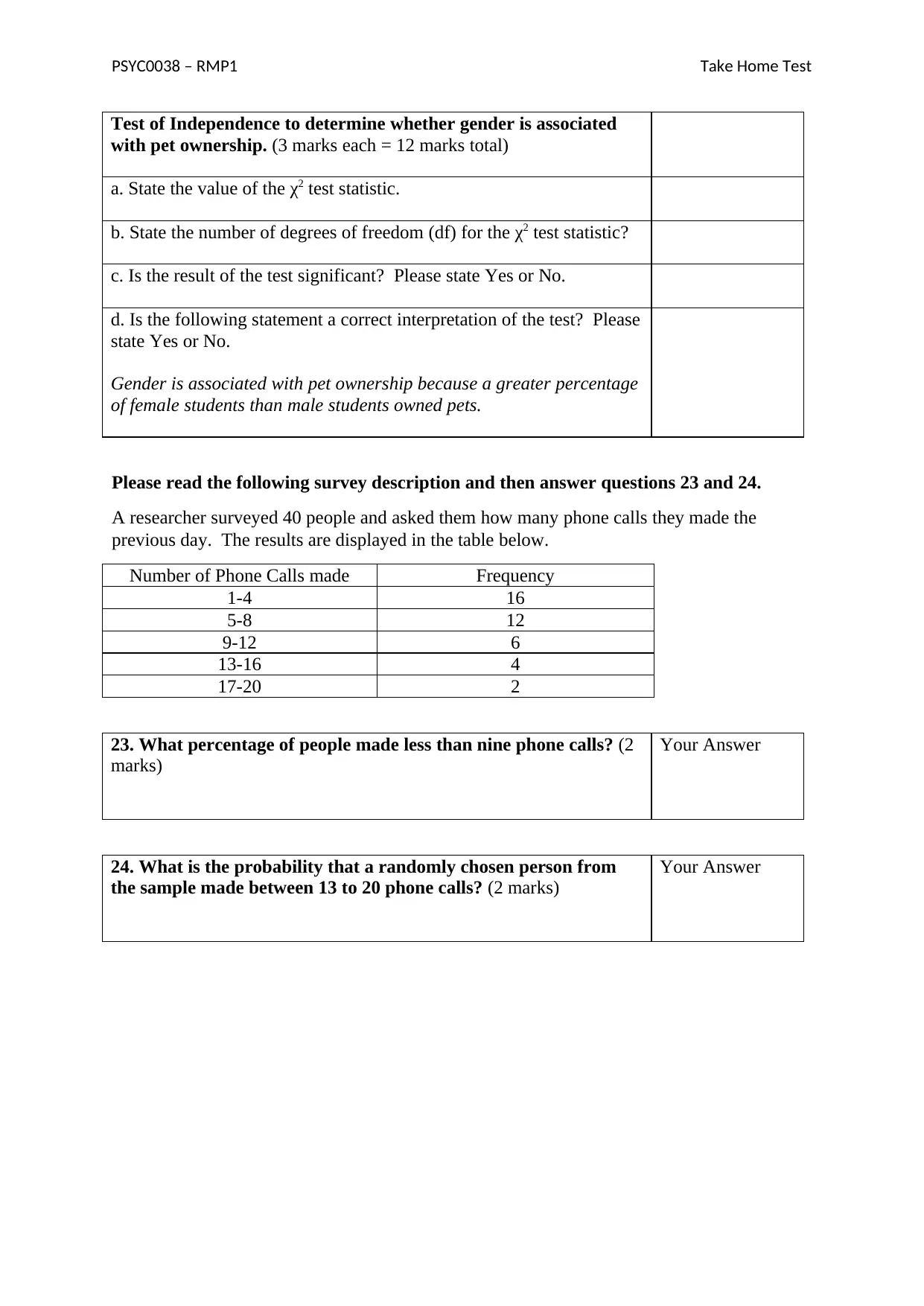
PSYC0038 – RMP1 Take Home Test
Test of Independence to determine whether gender is associated
with pet ownership. (3 marks each = 12 marks total)
a. State the value of the χ2 test statistic.
b. State the number of degrees of freedom (df) for the χ2 test statistic?
c. Is the result of the test significant? Please state Yes or No.
d. Is the following statement a correct interpretation of the test? Please
state Yes or No.
Gender is associated with pet ownership because a greater percentage
of female students than male students owned pets.
Please read the following survey description and then answer questions 23 and 24.
A researcher surveyed 40 people and asked them how many phone calls they made the
previous day. The results are displayed in the table below.
Number of Phone Calls made Frequency
1-4 16
5-8 12
9-12 6
13-16 4
17-20 2
23. What percentage of people made less than nine phone calls? (2
marks)
Your Answer
24. What is the probability that a randomly chosen person from
the sample made between 13 to 20 phone calls? (2 marks)
Your Answer
Test of Independence to determine whether gender is associated
with pet ownership. (3 marks each = 12 marks total)
a. State the value of the χ2 test statistic.
b. State the number of degrees of freedom (df) for the χ2 test statistic?
c. Is the result of the test significant? Please state Yes or No.
d. Is the following statement a correct interpretation of the test? Please
state Yes or No.
Gender is associated with pet ownership because a greater percentage
of female students than male students owned pets.
Please read the following survey description and then answer questions 23 and 24.
A researcher surveyed 40 people and asked them how many phone calls they made the
previous day. The results are displayed in the table below.
Number of Phone Calls made Frequency
1-4 16
5-8 12
9-12 6
13-16 4
17-20 2
23. What percentage of people made less than nine phone calls? (2
marks)
Your Answer
24. What is the probability that a randomly chosen person from
the sample made between 13 to 20 phone calls? (2 marks)
Your Answer
⊘ This is a preview!⊘
Do you want full access?
Subscribe today to unlock all pages.

Trusted by 1+ million students worldwide
1 out of 14
Related Documents
Your All-in-One AI-Powered Toolkit for Academic Success.
+13062052269
info@desklib.com
Available 24*7 on WhatsApp / Email
![[object Object]](/_next/static/media/star-bottom.7253800d.svg)
Unlock your academic potential
Copyright © 2020–2025 A2Z Services. All Rights Reserved. Developed and managed by ZUCOL.





